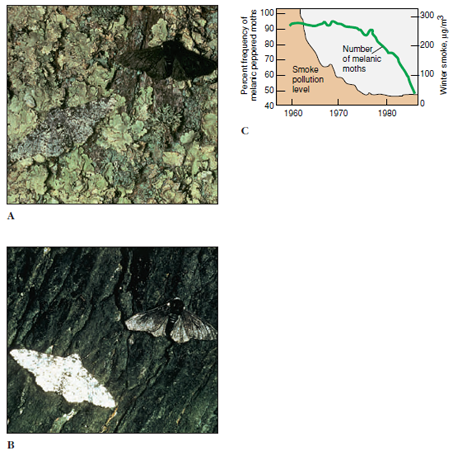Scientific Method
 |
| Figure 1-11 Light and melanic forms of the peppered moth, Biston betularia on, A, a lichen-covered tree in unpolluted countryside and, B, a soot-covered tree near industrial Birmingham, England. These color variants have a simple genetic basis. C, Recent decline in the frequency of the melanic form of the peppered moth with falling air pollution in industrial areas of England. The frequency of the melanic form still exceeded 90% in 1960, when smoke and sulfur dioxide emissions were still high. Later, as emissions fell and light-colored lichens began to grow again on the tree trunks, the melanic form became more conspicuous to predators. By 1986, only 50% of the moths were still of the melanic form, the rest having been replaced by the light form. |
The hypothesis of natural selection was invoked to explain variation observed in British moth populations (Figure 1-11). In industrial areas of England having heavy air pollution, many populations of moths contain primarily darkly pigmented (melanic) individuals, whereas moth populations inhabiting clean forests show a much higher frequency of lightly pigmented individuals. The hypothesis suggests that moths can survive most effectively by matching their surroundings, thereby remaining invisible to birds that seek to eat them. Experimental studies have shown that, consistent with this hypothesis, birds are able to locate and then to eat moths that do not match their surroundings, but that birds in the same area frequently fail to find moths that match their surroundings. Another testable prediction of the hypothesis of natural selection is that when polluted areas are cleaned, the moth populations should demonstrate an increase in the frequency of lightly pigmented individuals. Observations of such populations confirmed the result predicted by natural selection.
If a hypothesis is very powerful in explaining a wide variety of related phenomena, it attains the status of a theory. Natural selection is a good example. Our example of the use of natural selection to explain observed pigmentation patterns in moth populations is only one of many phenomena to which natural selection applies. Natural selection provides a potential explanation for the occurrence of many different traits distributed among virtually all animal species. Each of these instances constitutes a specific hypothesis generated from the theory of natural selection. Note, however, that falsification of a specific hypothesis does not necessarily lead to rejection of the theory as a whole. Natural selection may fail to explain the origins of human behavior, for example, but it provides an excellent explanation for many structural modifications of the pentadactyl (five-fingered) vertebrate limb for diverse functions. Scientists test many subsidiary hypotheses of their major theories to ask whether their theories are generally applicable. The most useful theories are those that can explain the largest array of different natural phenomena.
We emphasize that the meaning of the word “theory,” when used by scientists, is not “speculation” as it is in ordinary English usage. Failure to make this distinction has been prominent in creationist challenges to evolution. The creationists have spoken of evolution as “only a theory,” as if it were little better than a guess. In fact, the theory of evolution is supported by such massive evidence that most biologists view repudiation of evolution as tantamount to repudiation of reason. Nonetheless, evolution, along with all other theories in science, is not proven in a mathematical sense, but it is testable, tentative, and falsifiable. Powerful theories that guide extensive research are called paradigms. The history of science has shown that even major paradigms are subject to refutation and replacement when they fail to account for our observations of the natural world. They are then replaced by new paradigms in a process known as a scientific revolution. For example, prior to the 1800s, animal species were studied as if they were specially created entities whose essential properties remained unchanged through time. Darwin's theories led to a scientific revolution that replaced these views with the evolutionary paradigm. The evolutionary paradigm has guided biological research for more than 130 years, and to date there is no scientific evidence that falsifies it; it continues to guide active inquiry into the natural world, and it is generally accepted as the cornerstone of biology.




